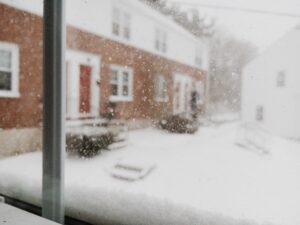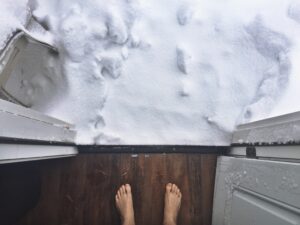There are people who question if weather stripping truly does work. The answer to this question is yes. Weatherstripping creates a tighter seal on your door, which helps keep the warm air in during the winter and the cool air in during the summer. If you are asking this question, I would bet that you have many more questions about weatherstripping. Which products are effective? What are the main types of weatherstripping? How do I use them? These are all questions this article will answer.
Does Weatherstripping Really Work?
Weatherstripping can make a big difference in your home’s energy efficiency. It helps keep the warm air in during the winter and the cool air in during the summer. There are a few different types of weatherstripping that you can use on your door and other places. The most common type is the vinyl strip. This type is easy to install and is very affordable.
How Does Weatherstripping Work?
Weatherstripping is a sealant for your door. It is placed around the edge of your door to create an air-tight seal when the door is closed. If you are wondering what weatherstripping looks like it, is a flexible piece of material that can be attached or removed at will.
- You just need to find the areas where there will be gaps between your doors and jambs.
- There are some people that question weather stripping and whether it really works. A better question to ask would be “how does it work?”.
- The answer is pretty simple. It creates a tighter seal on your door, which helps keep the warm air in during the winter and the cool air in during the summer.
There are a few different types of weatherstripping that you can use on your door. The most common type is the vinyl strip. This type is easy to install and very affordable.
Where Do I Place Weather Stripping
There are a few different places where you can place weatherstripping in your home. You can place it around your doors, windows, and even the bottom of your door.
- You should make sure that you are placing weatherstripping under all of your doors.
- If there is a gap around the side of the door frame, you will want to put some on that spot as well.
- You can also place weatherstripping at the base
- You can also use it on the bottom of your door to help keep the heat in during the winter.
- If you have a pet door, you can place weatherstripping around the edges
How Do I Choose Weather Stripping
Choose weatherstripping that is durable, weather, temperature-resistant, and wear-resistant. When used on a door bottom or threshold, weatherstripping might scrape against carpet or erode as a result of foot traffic.
- Window sashes must be constructed to slide smoothly up and down, sideways, or outward.
- When the door or window is closed, the weatherstripping you select should seal well but enable it to open freely.
- You’ll also need to pick a product for each distinct location.
- Felt and open-cell foams are often low-cost, incommode, visible, and ineffective at blocking airflow.
- The ease of application of these materials may make them appealing in low-traffic places.
- Vinyl is a flexible and long-lasting material It looks great and is easy to clean because of its polished finish.
- It does not hold moisture or mildew well, however it does not stain easily.
Metals (bronze, copper, stainless steel, and aluminum) last for years and are expensive. Metal weatherstripping can also provide a nice touch to older homes where vinyl might seem out of place.
What Types Of Weatherstripping Are Available?
Some seal better than others but they all have the same purpose which is to stop air from coming in or going out. There are three different types of common weatherstripping:
Expanding Foam:
This type of weatherstripping is best for small gaps. It comes in a can and you use a gun to spray it in the gap. When it dries, it will expand and fill the gap. It is easy to install and very effective when it comes to sealing air out.
- It does take up some space in the door or window frame.
- This can mean that your door or window may not close properly.
- This type of weather stripping can be applied by hand and it expands to 3 times its size after the chemical inside the weatherstrip reacts with the air.
- This is a quick-acting sealing system that can be used on doors that open inward, outward, and windows.
Metal-spring weather stripping
Metal-spring weatherstripping is used on doors that open inward and it has a metal strip that attaches to the door frame and a rubber seal that attaches to the door.
- This type of weatherstripping is very durable but can be difficult to install.
- It is recommended you get a professional to install this product.
Vinyl/Rubber
The cheapest option which makes them perfect if you are new to weatherstripping, it’s easy to install and is very effective.
- This type of weatherstripping is available in different colors and thicknesses.
- It can be used on almost any door.
The one thing you need to know is the usage and climate of the door or window. This will guide you on which one to use. If you’re not sure, it’s always best to ask a professional.
Which Type of Weather Stripping Is Best?
This question is difficult to answer as each person’s needs will be different. What works well for one home may not work out so well in another. The best thing to do is to evaluate the doors and windows, taking a look at what they have now and seeing how it’s working. Then you can start looking for products that will fit your needs.
Climate
The climate of your area will help you decide which type to use as the climate will determine what is best for your climate.
- Dry climates are best suited for expanded foams while most other climates will suffice with vinyl.
- If you live in a wet climate, then you should go with vinyl or rubber weatherstripping.
- If you live in a windy climate, then you should use metal-spring weatherstripping as it is the most durable.
Not all weatherstripping is best for any window or door. The climate is important to understand in order to pick the best weatherstripping for your home.
Types Of Doors And Windows
The type of door/window you have will determine what type of weatherstripping you will need.
- For sliding windows, some vinyl or metal-spring weather stripping with adjustable spring tension might be best.
- A door jamb is a vertical surface at the bottom of a door where it meets the floor.
- The edge of the door that contacts this surface must be sealed to prevent air leakage.
- For a door with no weather stripping, you can use some silicone caulking to seal the joint.
- Windows need weatherstripping on the top and sides as well as the bottom.
- You can use a variety of weather stripping on a window, but it is important that you use something to seal the space between the window frame and the wall.
Windows that open, like casement windows, also need weatherstripping on the hinges. Weatherstripping is also available for storm doors.
Door Or Window Usage
How often the door is used will determine what type of weatherstripping you should use. For a door that is used often, you should use something durable, like metal-spring weatherstripping.
- If the door is not used often, then you can use a less expensive option, like vinyl/rubber weatherstripping.
- If the door is only used a few times a day, then you can use a less durable option such as felt or open-cell foam.
- If the door is going to be used frequently, then you should go with a more durable and expensive option such as vinyl or rubber.
If the door or window that is being weather stripped will be used frequently, then it might be better to have a professional install the weatherstripping as there are many details required for a neat job.
Pets
If you have pets that like to run in and out of the house, then you should use durable weatherstrippings such as metal-spring or vinyl.
- This will help keep the weatherstripping from being damaged and prolong its life.
- How To Install Weather Stripping
There are many ways to install weather stripping, but the following is a general guide that indicates the most effective way. Once you have considered all of these factors, you will be able to choose the best type of weatherstripping for your needs.
Summary
Weatherstripping is a very affordable way to save energy. The three different types of weatherstripping all have different advantages and disadvantages. It is important to keep in mind your climate, the type of door/window you are weatherstripping, what type of weatherstripping will be best for how often it will be used, and if you have pets.
It is important that the weatherstripping is installed properly in order to be effective. Be sure to research weatherstripping on the Web to find out more detailed information. Now you are ready to make an educated decision when it comes time for you to choose the type of weatherstripping that is best for your needs.



